Friday October 28, 2016
Hangzhou, 28.10.2016
Some of us will travel back home tomorrow; so it is good that we all have breakfast all together at one table.
Carl hands me back an issue of the New Yorker magazine, which I had lent to him. We briefly discuss an article about Ursula K. Le Guin, a famous SF writer, who lives in the country and drives to New York regularly to give lectures. She comes from a family of which members are all good at telling stories . I myself dived into Chinese porcelain because it seemed natural, after hearing so much about it from my father.
Driving through Hangzhou we learn from our guide Emily that this city has a rather well-to-do population and a university attended by many students. The buildings we pass by are looking friendlier than the ones in e.g. Guangzhou: the architectural lines seem rounder and thus softer. We drive along garden walls and palm trees, which creates a Mediterranean atmosphere.
The Guan kiln is our next stop; it is the site where the Southern Song
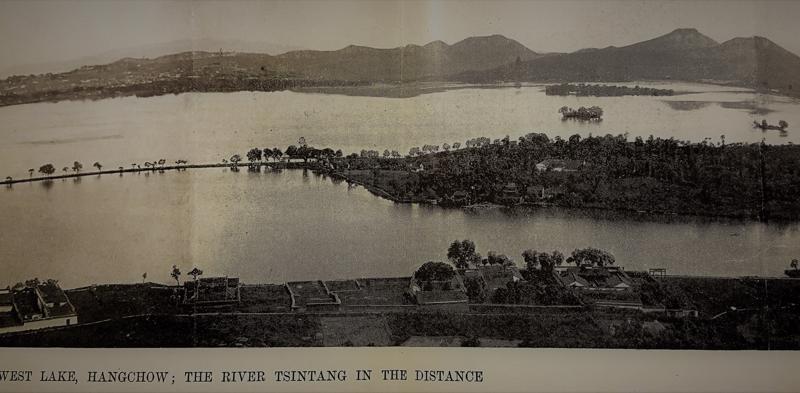
produced celadons for the emperors. The curator of the Hangzhou museum Du Zhengxian will guide us around. He is a famous curator as he, with other archaeologists, unearthed glass from a tomb from the period of the Warring states. We enjoy his wild gesturing while he explains us everything about the Guan wares. This kiln is about 800 years old; it was uncovered In 1985 and 1986 during the excavation of Jiaotanxia. The kiln site measures about 1,500 square meters. The workshop has been partly restored. Thousands of pieces and fragments of porcelain were found, together with many kiln tools.
He Li describes in his book “Chinese Ceramics” on page 132: “Song culture, unlike that of the cosmopolitan and colorful Tang was built upon highly principled rationality, which paid a great deal of respect to the classics of the Confucian tradition, hence art served a primarily moral and didactic purpose. In the ceramic industry this strikingly intellectual concept led artists to seek a perfect harmony of monochrome glaze colors with the shapes on which they were used. No other dynasty created such cool-toned, disciplined serenity in ceramics. The purity and subtlety of Song wares have been highly praised in Chinese literature through the use of such phrases as “resembling jade, silver, snow or ice.”
At the outskirts of Lin’an, which used to be the capital of the Southern Song dynasty, this kiln produced jasper colored celadons at a
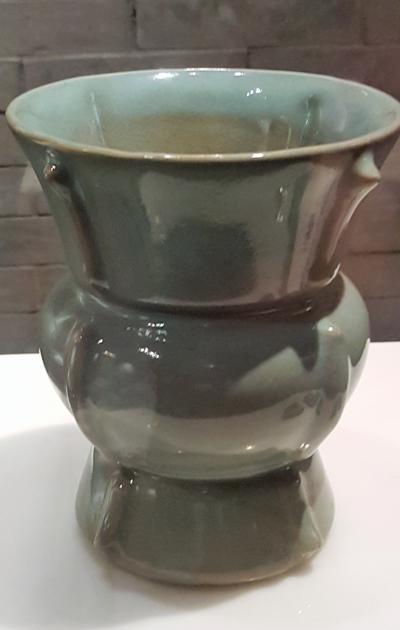

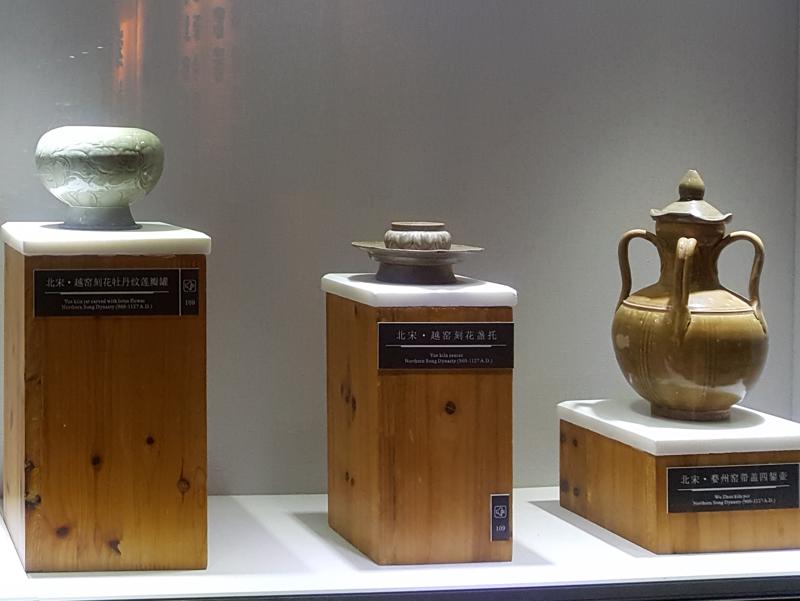
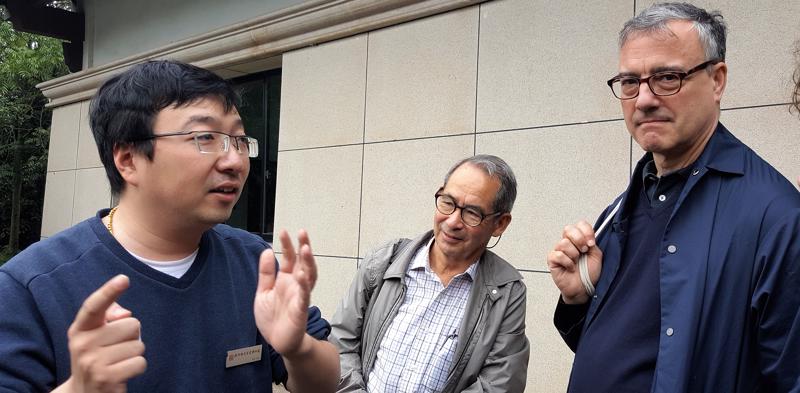
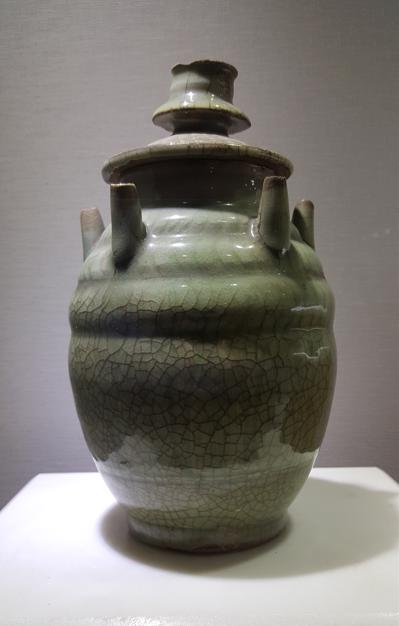
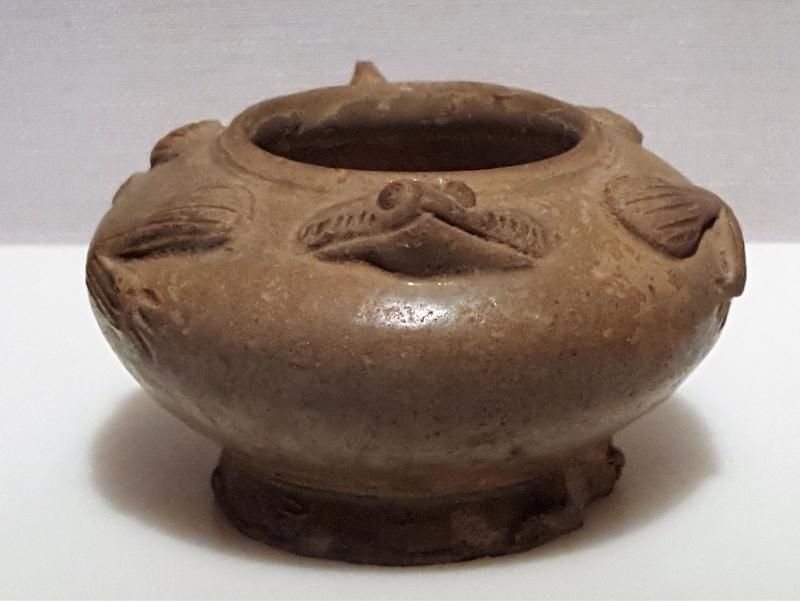
constant temperature. Celadon is highly praised as “ancient porcelain”- it reached the top of its fame with fine textures which look as if made from jade and ice. In fact, a strong lime-alkali emulsion was used. The Southern Song wares had a shiny glaze. In particular the lavender grey shiny glaze with jade-like texture had a restrained elegance.
Jasper, as a color, is an opaque variety of Chalcedony. The term jasper is used here to describe the unique, opaque, multicolored patterns, which may be a mixture of e.g. mottled green, orange, and black.
It is assumed, that the techniques applied by the Ru kiln (which produced porcelain that is exceptionally scarce today) were continued and further developed by the official kilns of the Northern Song and then the Southern Song, such as this Guan kiln. Their products have dotted spur marks, left on their exterior base surfaces, similar to the porcelain of the Ru and the official Northern Song kilns.
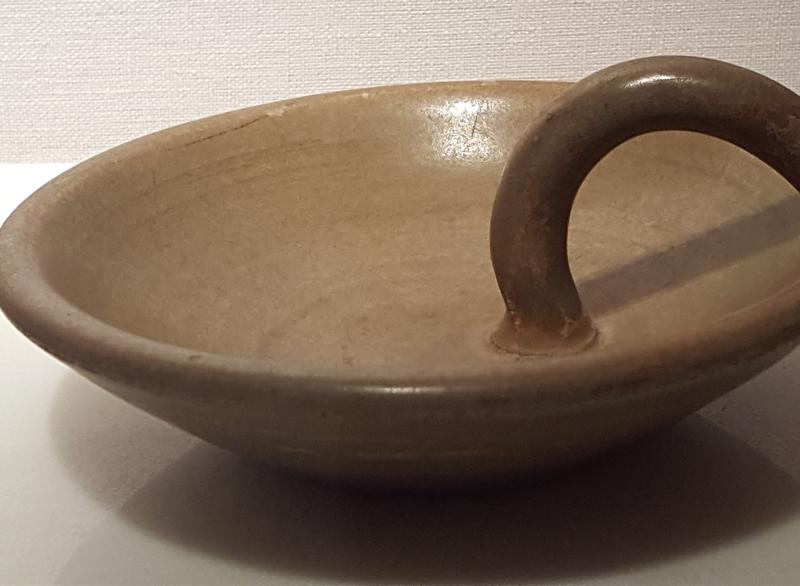

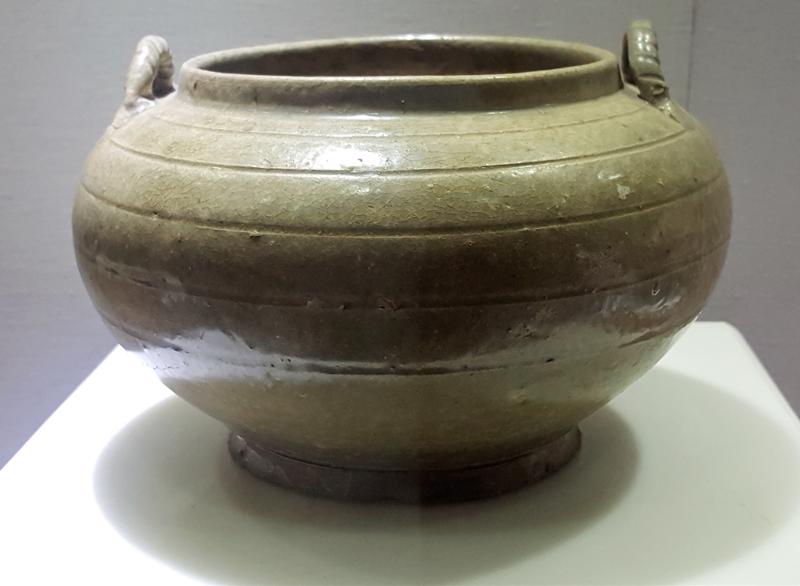
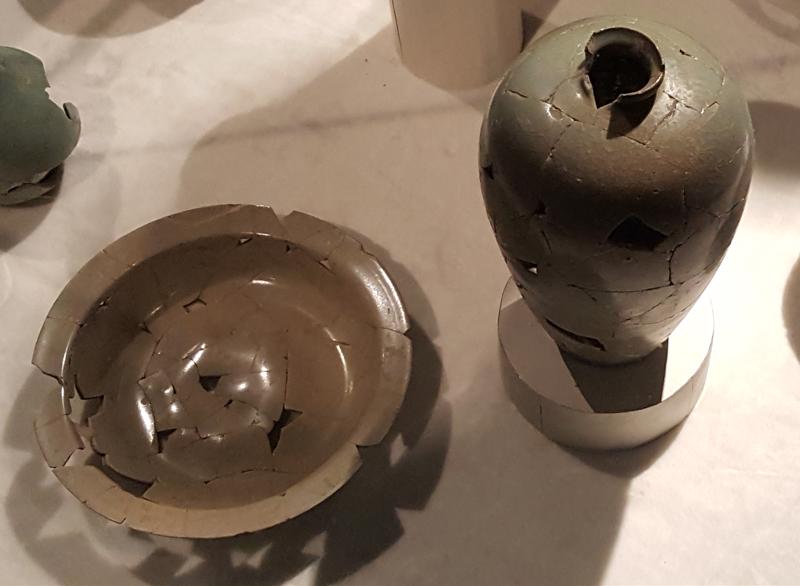
It was discovered from the unearthed shards at the Guan kiln, that products from the early period of the Southern Song dynasty official kilns mainly had thin bodies with thin glaze applied. Those from the middle and late period also had thin bodies but with thick glaze applied. Therefore the artistic effect given by thick glaze coating and jade-like texture stems from the late Southern Song period.
With respect to the glaze, which, as a consequence of the technical developments, had become thicker, a production method was developed called “Dry Foot”. The glazed wares were stacked on round wads. Under this method, the glaze at the ring foot was removed. In addition, supports and shelves were used to ensure a higher success rate for the production.
Another special effect, that of the Guan Crackled Glaze, is caused by the difference in expansion of the body and the glaze during the production process. It causes as a crackle which looks quite natural. The crazes, which sre irregularly spread over most of the glazing
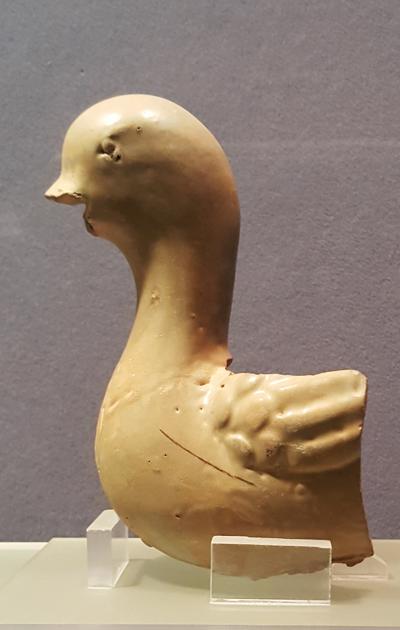
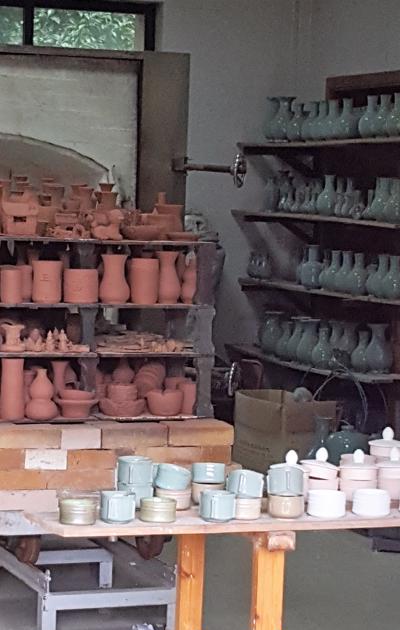
surface, are one of the major traits of these Southern Song kilns.
As for biscuit firing, greenware, loaded in saggars, was fired at temperatures in the range of 800 – 1000 degrees Celsius before glaze was applied.
The biscuit firing improved the absorption of the glaze and makes the greenware stronger, which increases the number of finished wares (by reducing the losses. Then, glaze was applied more than twice. Porcelain wares produced this way had thin bodies with thick jade like textures.
A critical tool for firing porcelains and stone wares is the saggar. So what is a saggar? A saggar is box-shaped and encloses and protects greenwares for example when fired in the kiln. Saggars are made of a fire-proof material; their shapes vary with the shape of the objects which are put in them. Therefore, saggars may be cylindrical, or funnel, or M-shaped - but also round or oval shapes were found during excavations.
Before the time that saggars became popular, porcelain was baked directly in open fire. This method easily caused ash and smoke stains on the finished product. The saggars for firing stoneware started to be used during the Southern Dynasties (420 -589 AD). Saggar usage for firing pots became more popular during the Tang Dynasty (618-907 AD) and continued to be used from then onwards.
We move on with the guide to one of the exhibition spaces where a Guan dragon kiln is
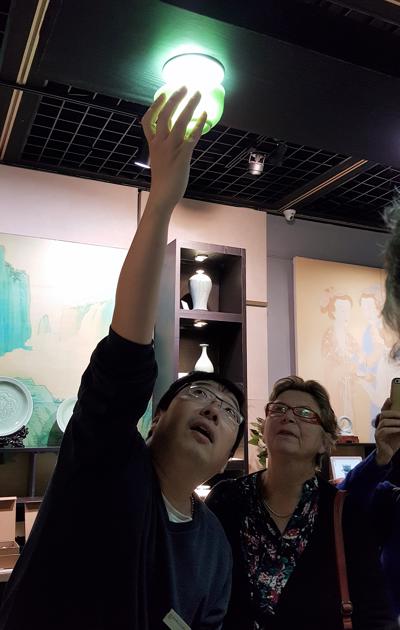
shown! Admiring kilns has become somewhat normal for us - during our trip we have seen one or even two kilns per day; but each kiln has something special. The Guan kiln is special for its crackled wares.
We continue to the other exposition rooms. Beautiful pots, shards and jars… The shards are shown in such a way that it is easy to see how the glaze covers the porcelain body: how it sticks to the porcelain body. The quality of the Celadons seems to be very high: the vases, jars, shards and bird feeders are a celebration for the eye. Our museum guide uses arms and legs to explain why the Guan production is so wonderful; his hands and feet fling into the air during the explanation! It is true what he says: the serenity of the forms is in harmonious balance with the opaque colors of the glaze!
He explains about the phenomenon of “Purple Mouth and Iron Foot” on the Guan wares: “After the firing, due to the high iron content of the clay, the pottery from the Southern Song official kilns had a dark grey or charcoal black color. Before baking, glazed wares were stacked on kiln shelves and subjected to a removal of the glaze from the foot rims. This made visible a regular circle of ferrous brown color at the unglazed foot rims after firing in the kiln. This method was colloquially named “Iron-Foot”. The dark purplish-grey body showed faintly through the glaze and ran thin at the mouth rim under high kiln temperatures. This was called “Purple mouth and Iron
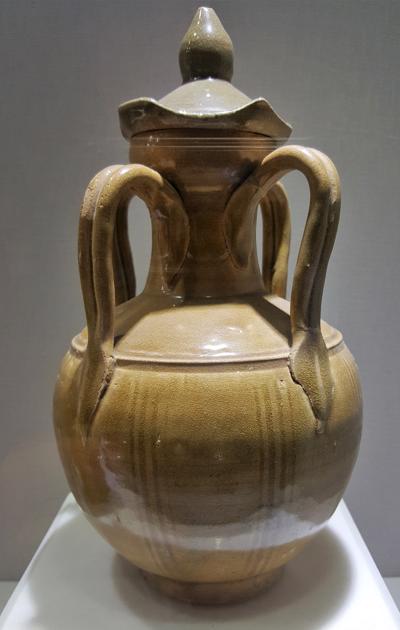
Foot”, which was held in high esteem by later generations.”
We enter in the Guan shop where many Guan wares are for sale. In her book on Song Dynasty Ceramics, Rose Kerr describes them with lots of details . I wish I had the book with me here.
The guide shows us the special items which are on sale: five cups, each made of different materials at different Guan kiln temperatures. The lower the temperature, the darker the jar. But I cannot buy much as it will make my luggage too heavy. So I buy something which does not have much weight: a small, globular, light green jar. Carl advises that I should take another one which is more typical for Guan. So I also buy a pot with big crackles: some holes in it and a lid. It is for incense burning; and it pleases me especially since it has that thick high glance butter touch to it. It will be a source of happiness for people who hold it. In fact, every one of our group buys something from the shop. Carl takes the five cups and small tea cups, white bluish with thick glaze (he plans to hand them out to friends and students). I buy two of those for fun and for whomever.
After leaving the shop we attend another of the exposition rooms: many shards are on show here; lovely Yue green Celadons from the Northern Song. Before the white porcelain from Jingdezhen became
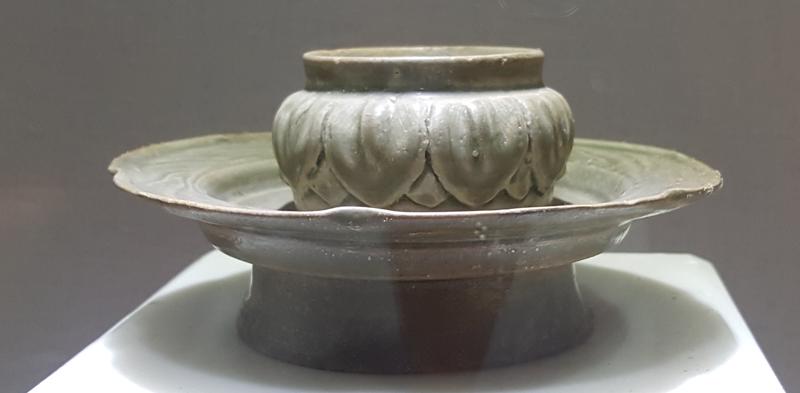
popular, these green and grey wares were traded a lot during the Song and the Tang. Their form and shade were of major importance.
Walking back to the car park we see many special tree types. Wai Lan knows them all by name. We have passed two hours at the Guan kiln. Wonderful hours.
Due to the high iron content of the clay, the pottery from the Southern Song official kilns had a dark grey or charcoal black color. Also glazed wares using kiln shelves in the kiln (as a stacking method for firing) would receive a glaze removal from the foot rims before baking. It made a regular circle of ferrous brown color become visible at the unglazed foot rims after firing in the kiln. This method was colloquially named “Iron-Foot”. The dark purplish-grey body showed faintly through the glaze and it ran thin at the mouth rim under high temperature at the kiln. Therefor the phenomenon of “Purple mouth and Iron Foot”, which was widely held in high esteem by later generations, came into being.”
We enter in the Guan shop where many Guan wares are for sale. In her book on Song Dynasty Ceramics, Rose Kerr describes them with lots of details . I wish I had the book with me here.
The guide shows us the special items for which are sale: five cups, each made of different materials at a different Guan kiln
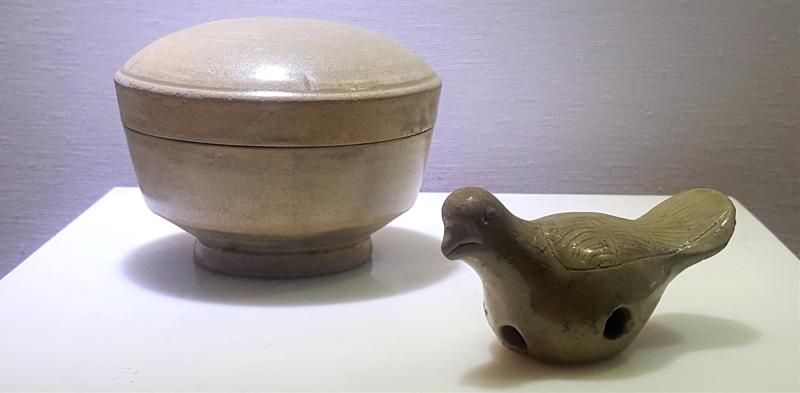
temperatures. The lower the temperature, the darker the jar. But I cannot buy much as it will make my luggage too heavy. So I buy something which does not have much weight: a small, globular, light green jar. Carl advises that I should take another one which is more typical for Guan. So I also buy a pot with big crackles: some holes in it and a lid. It is for incense burning; and it pleases me especially since it has that thick high glance butter touch to it. It will be a source of happiness for people who hold it. In fact, every one of our group buys something from the shop. Carl takes the five cups and small tea cups, white bluish with thick glaze (he plans to hand them out to friends and students). Sigh, I buy two of those for fun and for whomever.
After leaving the shop we attend another of the exposition rooms: many shards are on show here; lovely Yue green Celadons from the Northern Song. Before the white porcelain from Jingdezhen became popular, these green and grey wares were traded a lot during the Song and the Tang. Their form and shade were of major importance.
Walking back to the car park we see many special tree types. Wai Lan knows them all by name. We have passed two hours at the Guan kiln. Wonderful hours.
At 12:30 the bus drops us of at a scenic spot next to the Hangzhou West Lake. At Lou WaiLou, a famous restaurant (active since 1848, famous for traditional local food), a tasty lunch is served to us (Longjing tea, Beggars chicken, pork a la Dongpo). From our big, round table we have a superior view on the lake.
The landscape is filled with flowing mountains. At the foot of the mountains (Yang!) is the West lake (Yin!) with small tourist boats. Will the boats go up the famous Grand Canal which connect trade boats from Hangzhou to Peking since the Sui Dynasty? (The Grand Canal was fully completed under the second Sui emperor, from the years 604 to 609. First Luoyang was linked to the Yangzhou (and the Yangzi) valley. Then expanding it to Hangzhou (south), and to Beijing

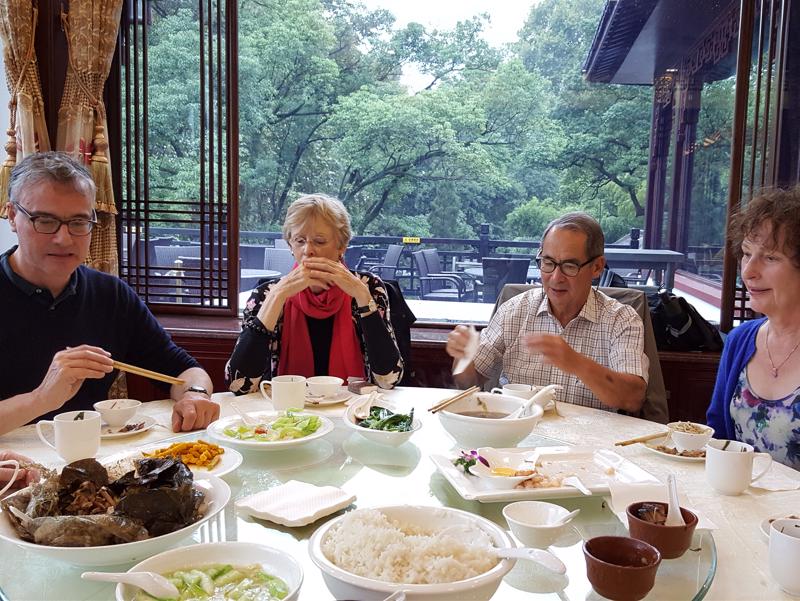

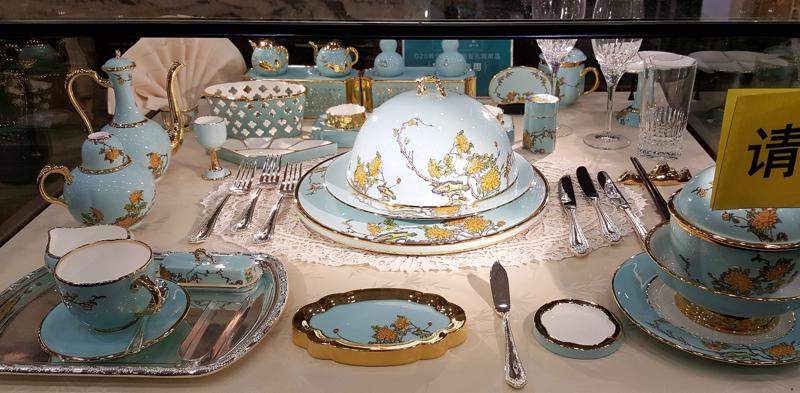
(north)). It is raining cats and dogs here, but the view of the mountains, lake, and boats, compensates for the grey overcast sky. In this area, for centuries, there has been integration of culture and nature. Scholars were inspired by this beautiful scenery and transformed it into art. In the 12th century, this area was the cultural, political and economic centre of China.
Su Dongpo (1037 – 1101 AD), a Hangzhou (Linan) governor and poet during the Song dynasty, built the Su Causeway, a magpie's bridge across the West lake.
I do not want to think about the fact that will go our own way in only 18 hours – then, I’ll be leaving for Shanghai from the Hangzhou station...
Interesting detail: during the G20 Summit which was was organized in Hangzhou (very recently) in September this year, Obama had an informal meeting, in this restaurant at West Lake, with Xi Jinping!
In they evening they drank tea together from light blue porcelain with Naples yellow flowers; enameled with yellow gold decorations and a very thick glaze – all designed especially for these two world leaders. It has now been put on show on a shelf: I hope, that Obama was

given some of it to take home, to his lovely wife Michelle! (To make this story even more interesting: 44 years ago, in 1972 China’s then Premier Zhou Enlai met with Richard Nixon here as well!)
After lunch we wait for the bus at the entrance of the restaurant. There is so much rain and we are encircled by large groups of visitors. Cute babies sit on mothers’ arms. Under the decorated canopy old men admire the view. All are waiting for the rain to stop. The magnificent view of the mountains, the lake with the boats, and the trees leaning against the wind inspires us.
The famous Song poet Su Dongpo was a master of calligraphy and painting as well. He had a difficult life though : being a governor, he was expelled several times from the Emperor’s court. As a painter, he introduced an expressionistic style in favor of the traditional realism. He sings about his life and the moon that shines on the West Lake. In one of his famous poems called “Zhouzhong ye qi”....(See in the French Pleiade series: translated from Chinese: “Nocturne en barque” or “Arise at night on the middle of my boat”).
The Zhejiang Museum – it used to be called the West Lake museum
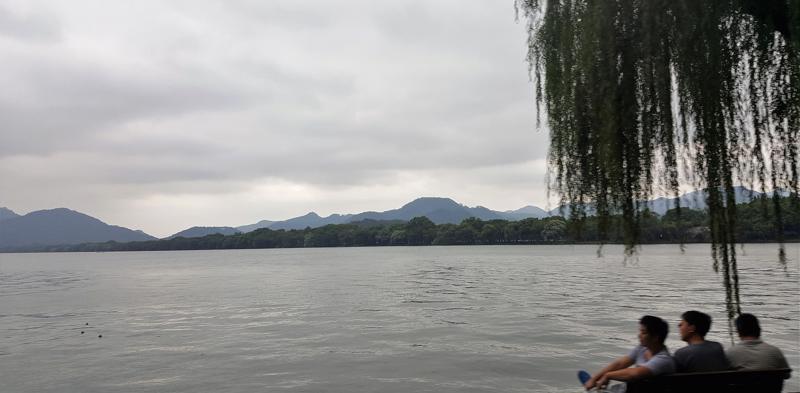
– is next on our schedule.
In the main building of this museum lots of porcelain is on show. Over 100,000 cultural relics including pottery and lacquer wares; wooden, bone and ivory objects from the Hemudu culture; jade articles and fabrics from the Longzhu culture; bronze wares from the state of Yue (one of the Warring states, 475 – 221 BC); celadon wares from the Yue kilns; longquan kiln and the imperial kiln wares of the Southern Song Dynasty; the Guiji Mirror and the Huzhou Mirror as well as the works of calligraphers and artists of the Zhejiang province in the Ming and Qing Dynasties can be found in the museum!
This museum has several buildings allocated to celadon, painting, handcraft and historical objects; and calligraphy. All the objects are displayed in different settings throughout the year as “objects from the treasures”. I enter an exhibition room with celadons ; they are fabulous. The shapes, forms and colors are matching so graciously! But, again, there is very little information in English. Nevertheless, from the few information boards which do read in English I learn some interesting information – in summary:
The dominance of celadon in China was overthrown by white porcelain. White porcelain came from Northern China during the transition from the Tang(618 – 907) to the Song (960 – 1279). This white porcelain from the Ding kiln in the North surpassed the celadon of the Yue kiln in quality and quantity. However, after the Northern
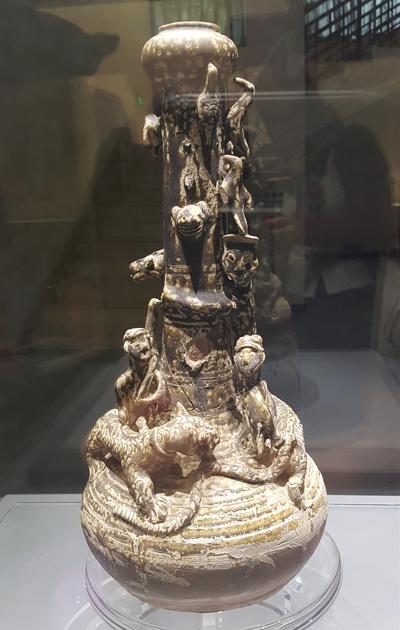

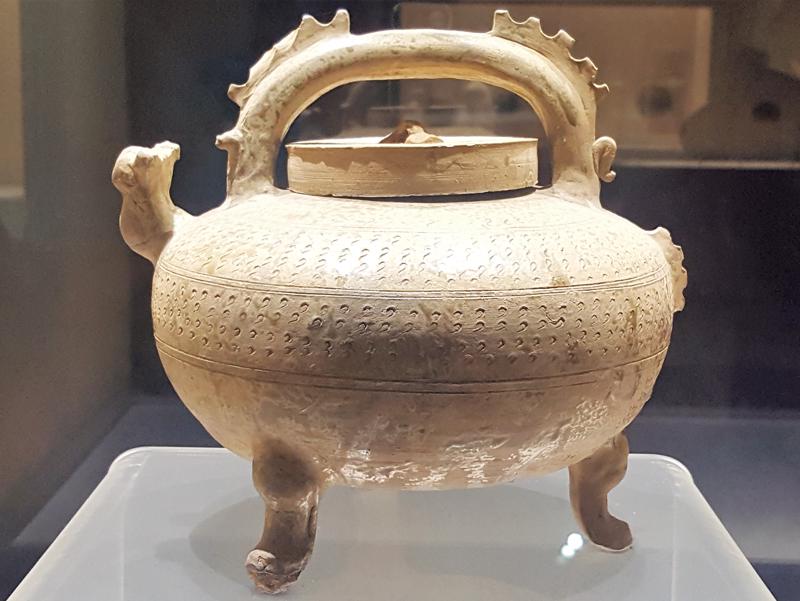
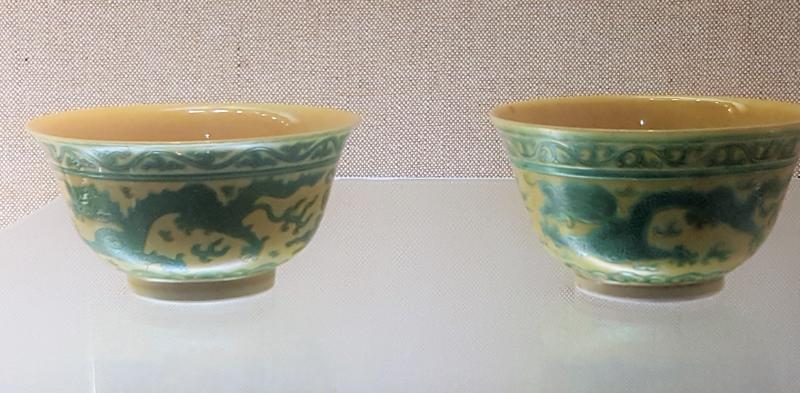
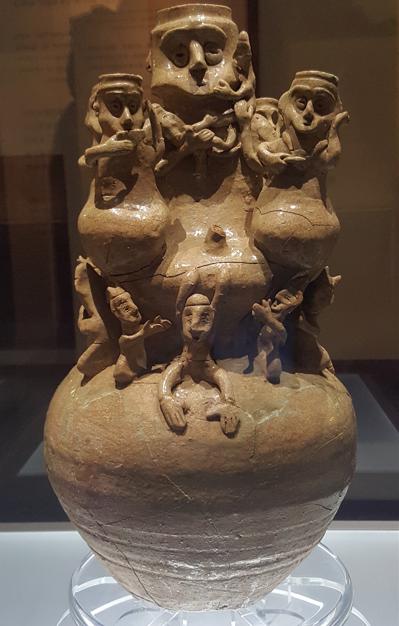
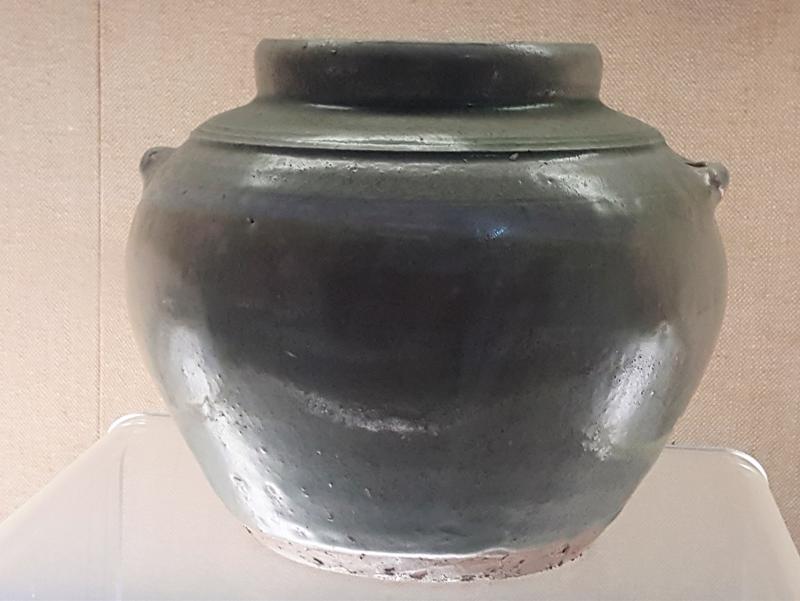
Song came to an end (in 1126 - due to the conquests of the northern and western parts of China by the Jin and Mongols –it was Jingdezhen that became the most important place for the production of white (and blue) porcelain.The white glaze on porcelain from the Yuan Dynasty (1279–1368) became quite popular with the Emperors even. During the Ming (1368-1644 AD) and the Qing (1644-1912 AD) Dynasties the government established officially chartered kilns in Jingdezhen.
The production of clear white porcelain laid the foundation for the colorful polychrome glazes. The celadon industry, which, in the meantime, had declined in Zhejiang was passed on to Jingdezhen as well.
The museum also shows porcelain from the Neolithic, Tang, Song, Yuan, Ming and Qing periods. It is important to realize that the Southern Song states became very strong.. The land was very fertile in the South for agriculture. The Southern Song also developed and professionalized its naval forces, to defend the borders and explore maritime routes.
Subsequently I enter the Huang Binhong Art department of this museum. Huang Binhong was one of the last literati painters, famous for his freehand landscapes. He was the grandson of Huang Fengha and became associated with painters in Shanghai, later on with Hangzhou painters. Some
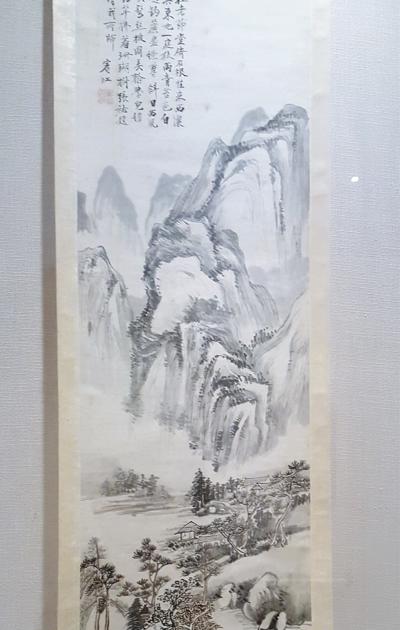
strongly accented paintings of the Chinese literati type landscapes appear before the visitor’s eyes. This museum has so many beautiful and interesting objects… unfortunately, I need to keep pressing on, as time is limited.
About Huang Binhong , mentioned above, much has been written. There is, for example, a beautiful book about his friendship with the younger artist Fou Lei. It charts a friendship between two creative individuals who played important and different roles in the evolution of Chinese culture in the twentieth century:
“In 1943, Fou Lei (1908-1966), a young Shanghainese intellectual who had spent time in Paris, wrote a letter to the eighty-year-old artist Huang Binhong, a man more than forty years his senior. Huang Binhong (1865-1955), also from the south, was then living in Japanese-occupied Beiping (the name for Beijing from 1928 to 1949). He felt isolated in this unfamiliar, politically oppressive city. While the paths of the two men had crossed years before in Shanghai, Fou Lei's letter marks the beginning of an intense artistic exchange of ideas that continued until Huang Binhong's death in 1955.”
The scrolls in the Museum are beautiful…
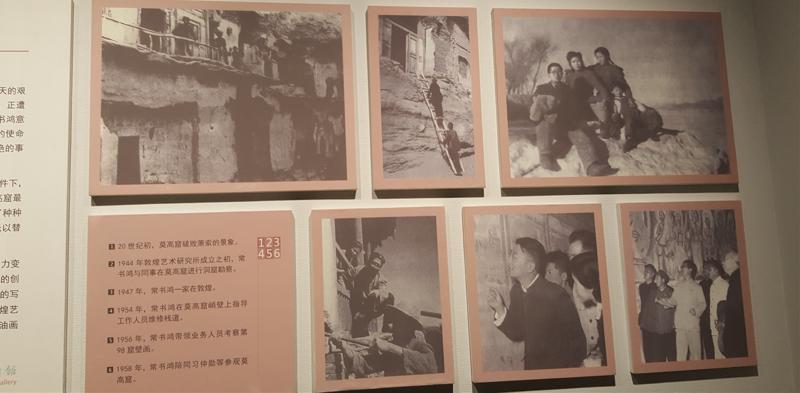
Then I follow the museum route to the jade and stone seals department with beautifully carved animal head knobs. On my way I cross a garden with lovely Chinese trees, flowers in many colours with petals stretched out to the grey sky.
Via the same Museum garden I enter a hall dedicated to the painter Chang Shuhong (1904 – 1994 AD) who was born in Hangzhou (see link below). He studied dying and weaving in Zhejiang’s Industry School; went to France in 1927; studied there for almost ten years and won awards for his paintings. One day, in Paris, he found a book at one of the bouquinistes (bookstalls along the quay on the Seine) called “Selected Art Works at the Dunhuang caves” – compiled by Paul Pelliot –, a retrospect on age-old Chinese tradition. These Mogao Caves, also known as the Thousand Buddha Grottoes (qiān fó dòng), form a group of 492 temples. They are located at 25 km southeast of the center of Dunhuang, which is an oasis, strategically located at religious and cultural crossroads of the Silk Road in Gansu
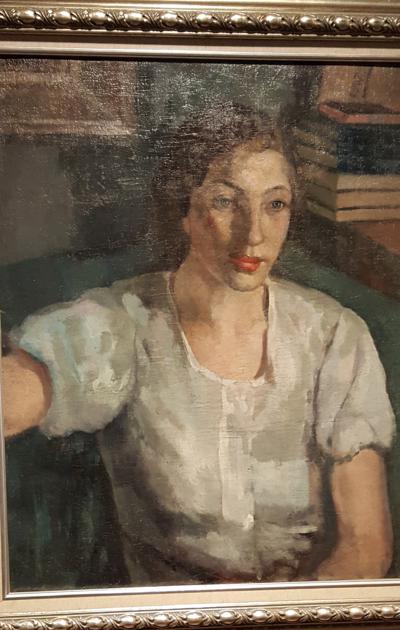
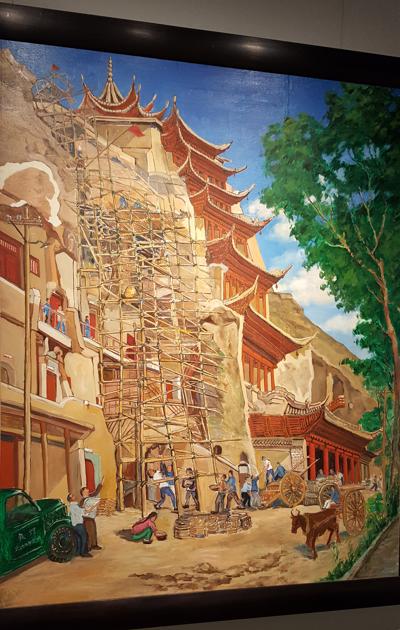
province, China.
Reading this book changed Chang Shuhong’s life; he wanted to see the Buddha grottoes existing in China Chang and went back to China in 1936. By doing this, he gave up his tranquil life: at that time the Japanese were striking hard and cruelly at his motherland. Later on, from 1943, Chang investigated the Mogao grotto for the Institute of Art.
In this exhibition hall, I admire his paintings. Sometimes the colours are purposefully spread out to a large extent. Sharp lines Chang painted – he had a clear and bright style. There is a lovely ice skating scene; and a painting of the entrance of the Mogao Caves. The photographs of the painter, his family and friends are great too.
There seems to be a mix of East and West in this painter’s work which is very interesting. Willem Scheurleer (Japanese porcelain Kozan and Seifu scholar of the VVAK) taught me a lot about the fusion in arts and culture (of East and West) that took place at the start of the 20th century.
My watch tells me: “one hour left…”, so I move on to the calligraphy exposition; an exposition of the life and works of the famous
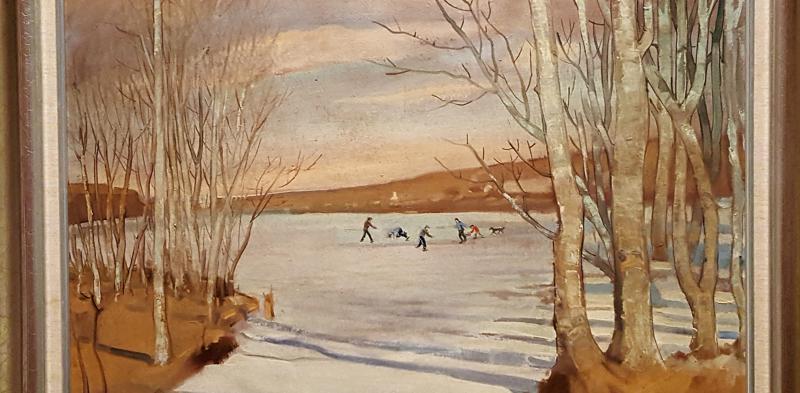


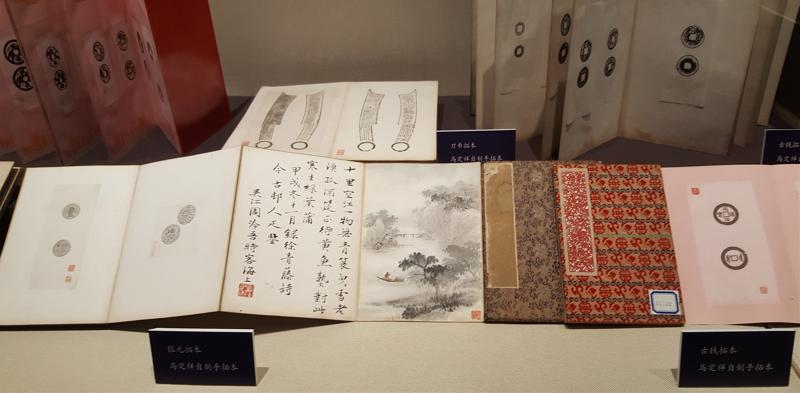


Hangzhou calligrapher Sha Meghai (see link at the bottom of the page). No chance to read the calligraphy; this great art is perceivable with your soul though: characters are masterfully calligraphed with the brush.
Sha played an important role during difficult political events; the Communist party made him head of the Zheijang Museum’s history department in 1954. He stayed in touch with his calligraphy teachers; nurtured his love of calligraphy and created beautiful books and scriptures throughout his life. The pictures of Sha with his father; his family; his teachers; scholars and officials; in costumes at performances are breath-taking because of the atmosphere, and also because they make you realize, that the times have changed a lot in China as well.
I still have 30 minutes left; I spend them in the hall with lacquer and
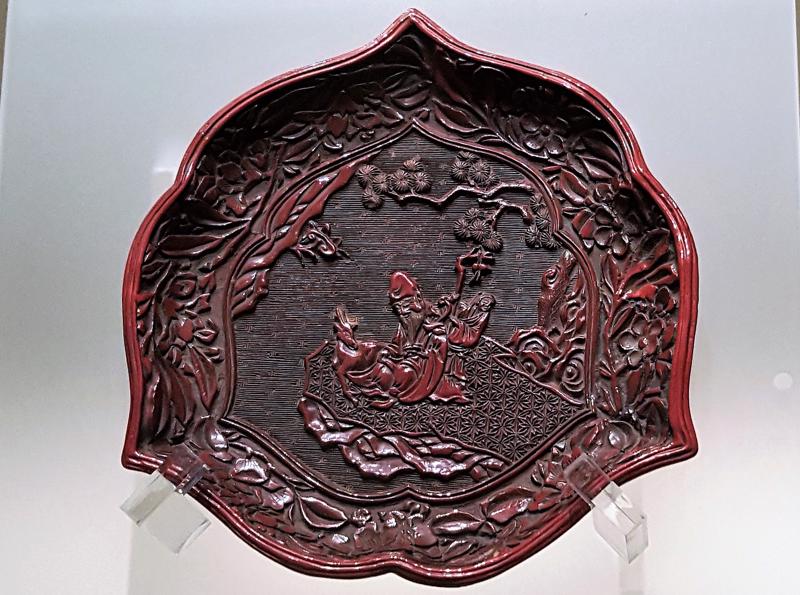
carved objects. Multiple boxes and wares are being exhibited. Early Ming Dynasty decorations were made under the reign of the Ming Emperors Yongle (1403 - 1424 AD) and Xuande (1426 – 1436 Ad).
The techniques for carving in the early Ming periods came from the Yuan dynasty lacquer carving masters Zhang Cheng and Yang Mao. The lacquer is red among other colours. The objects were characterized by thick lacquer layers, smoothly carved patterns and intense polishing. The themes on the objects were: the four seasons, landscapes, flowers, figurines, dragons and phoenixes.
The late Ming dynasty famous, decorated objects were made during the Jaijing (1521 – 1566 AD) and Wanli (1573 – 1620 AD) reigns. The most popular carving techniques were, at this time: red lacquer carving and coloured lacquer carving. These styles featured skilful use of shape knives, less polish and clear carving edges. The work of the Late Ming signified the beauty of concise carving edges and


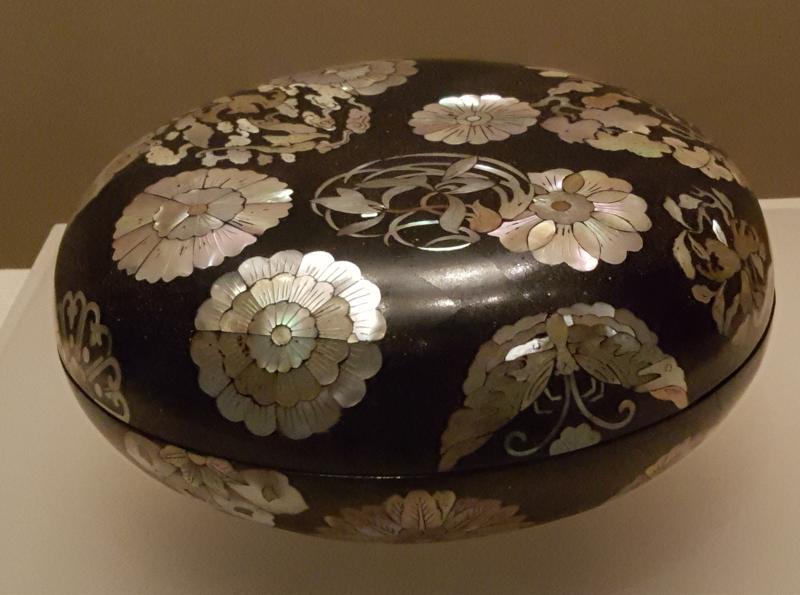
delicate patterns. Developed from its earlier simple and mellow styles, the lacquer carvings showcased a luxurious and exquisite new ornamental style during the late Ming (1521 – 1620 AD).
A box had several compartments for the storage of tea sets, utensils or food. Men of letters carried them when they were out for a trip. Such hand boxes/ portable caskets were developed for a popular hiking tour during the Song Dynasty.
At the entrance of the museum the group comes back together; we admire the many goldfish that move around in wide circular loops, in the museum pond.
The sky is getting more overcast; it is cold outside and it rains. We leave the Museum and continue the walk along the lake, towards a wooden tourist boat. Emily buys tickets for us. Carl, Truke, Christine and I sit outside at the back of the boat. The boat leaves. The wind
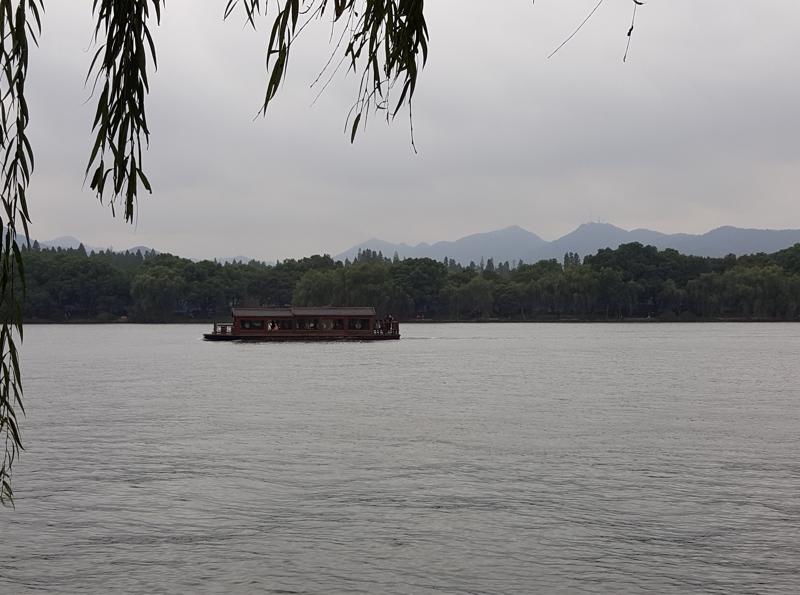
feels cold as ice. Surrounded by mountain peaks, pagodas, dragons and rain drops we float; it reminds us of Chinese pottery scenes. Carl and Ting-tiang make me stop complaining about the cold. In the distance we see the Lei Feng Pagoda: it is one of the famous “ten sights” of the West Lake. In fact, it is a reconstruction of the old pagoda: the original pagoda collapsed in 1924. Due to a superstitious belief that the bricks from the tower would repel illness or prevent miscarriage, many people stole bricks from the original tower (to grind into powder and swallow) - and so many stones were stolen that it collapsed.
The West Lake is famous for its role in the Legend of the White Snake. The white snake practises Tao while living in the West Lake. She swallows a pill with the gift of eternal life; she then saves a green snake who once tried to swallow the pill before she did. The white and green snake become very close friends and then transform into two beautiful women. And then, the white snake meets the man of her life. He is the immortal, who originally let her swallow the immortality pill…and then, they love each other for ever and ever.
About the West lake, Su Shi (Dongpo) wrote poems during the Song reign. This one tells us, what he saw when it rained and stormed, on the 27th day of the sixth month, years and years ago:
Sixth month, 27th day
Written While Drunk on Lake Prospect Tower
'Wanghu Lou zui shu wu jue'
Su Shi
Swirled ink of black cloud has not yet covered the hills,
Jumping pearls of white rain riotously enter the boat.
A wind to curl the earth up comes, in an instant blows them away,
And under Lake Prospect Tower water seems sky.
The fish and turtles it's forbidden to catch come as near you as they please,
The lotus blossoms no one owns open wherever you go.
Pillowed on water you can order the hills to tilt up, tilt down.
The boat in the breeze has got the knack of ambling round the moon.
Come, take from time the leisure's share you will.
Semi-retirement is retirement still.
Where better could I settle and find a home
Than such a place with peerless lake and hill?
Su Shi (Dongpo) is especially famous for his poem “Ode to the Red Cliff”, which is exhibited on a handscroll in the National Palace Museum in Taipei. It was written during the sixth year of Yuanfeng during the Song period, when Su was 48 years old.
Two dragon boats pass our boat. The cold wind drives us to the inside of the cabin, where we find the guide. She tells us about Hangzhou and West Lake. From a plastic bottle she sprays (asmalthus) flower scent above our heads. A nice gesture of course, but: that genuine, natural smell of real blossom… well, we do not smell it yet…
------------------------------------------------------------------------------
The National Palace Museum information about that scroll gives below information: “In the fifth year of Emperor Shenzong's Yuanfeng reign (1082) in the Northern Song period, more than 800 years after the epic Battle of Red Cliff, the famous poet-official Su Shi (Dongpo) and friends made two trips to Red Nose Cliff west of the town Huangzhou. To commemorate these trips, Su wrote two rhapsodies that would earn him universal praise in the annals of Chinese literature: "Odes to the Red Cliff." Afterwards, Red Nose Cliff at Hangzhou became known as "Dongpo's Red Cliff," which is actually not the place of the battle but not very far from it.
For Su Shi, this was also a time when he had to endure the hardships of exile from court that resulted from the Wutai Poem Incident (????). In his rhapsodies Su yearned nostalgically for the daring bravura of heroes who fought at Red Cliff centuries earlier, while also facing the realities of life's brevity and the hypocritical nature of people. Consequently, he was able to develop a clear and philosophical form of critical self-examination on the aspects of change and permanence. It was exactly the predicaments of his personal difficulties at this time that made it possible for Su to see through the veil of history and make the trips to his Red Cliff passed down and commemorated through the ages.”
Find here the translation of the Red Cliff poem and enjoy here below the translation of the rimes by Su Shi (Dongpo):
“You and I are fishing in the river, gathering firewood in the islet, with fish and shrimp as our companions and milu (deer) as our friends, and riding a boat while drinking from our simple gourd cups.”

“We are like mayflies wandering in this terrestrial world or a grain of millet drifting on a deep ocean. What a short life span we have, yet how endless the Yangtze River is!”
Many poets tried their talents on West Lake….on the boat we absorb the stunning views.
-------------------------------------------------------------------------
No phone is in between me and the scenery: the battery ran out of power. I think of Sam and Marion: they must be talking to a curator in Beijing right now. They would have enjoyed it here!
Back from the boat trip, on the border of the lake, we plan ahead for the rest of the evening – as usual this is about who goes where and who goes elsewhere and how to come together again. I buy Oolong tea in a shop. Bente, Christine and Wai Lan go to a market somewhere. The bus brings the rest of us back to the Pearl hotel. The traffic is terrible again. Truke, Ting-tiang and I have loud conversations in the back of the bus on all the art objects seen today. Carl sits in front of the bus, he forgives us for speaking Dutch .
I phone Pieter from my hotel room with a cup of oolong tea in my hand. He has had some very warm days in the Netherlands - amazing for this time of the year: end of October! For sure the climate issues arising in the world do not come only from the West:
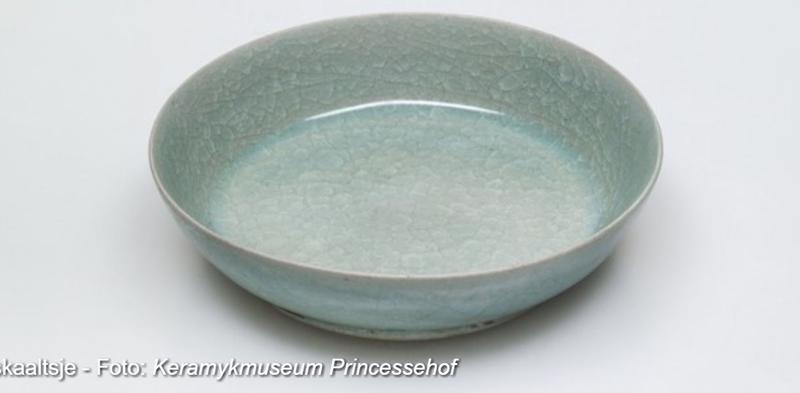
many cities in China are full of smog and unhealthy as can be for lungs and skin – the rapid urbanisation and increase of the number of cars are the main cause of this huge problem. Eco-cities like Tianjin in China are being built – that makes one feel positive for the future: 285 more Eco-cities will be built!
My own future needs a plan too: how will I stay onboard in the highly combative male IT environment? I enjoy Chinese (and Japanese) art, religion and history, but I will go back into my working life. It will be great however to sit in the small kitchen at home with Leila the cat on my lap; having dinner with Pieter; hearing about literature, French poetry, classical rhetoric, history, philosophy, Hegel, gnostic ideas... Follow the heart the Jung way!
I go to Carl some rooms further down the corridor; he is busy working as always. Could we do a handstand together here in the corridor? On the fourth floor of the Pearl hotel our feet go up. Carl stands on his head without leaning his feet against the wall even. We finish with the “baby posture” to relax. Then we salute each other: hands folded in front of us, we bow our heads, smiling; and rush back to our rooms, to prepare ourselves for dinner.
Emily points us to a restaurant for dinner tonight: we only have to walk over there. Around the corner of the hotel is a main street. In the cold we stroll along the street looking for the restaurant. But it is hard to find. I catch the attention of a gentle looking Chinese man. He speaks English! He points us to a high floor of a huge building. We enter the building; take the elevator; and… see the restaurant!
Sparkling groups of guests pass through the restaurant hall. They are expensively dressed. The elevator spits out more and more of them. It looks like a wealthy, materialist style is en vogue here. A kid comes over and wants to take a selfie with me.
Christine gives the group a good bye speech. She gives us an icon: a smiley magnet in different colours.
Christine, together with the Wen family (Ting-tiang and Wai Lan), did a great job in organizing this trip: it was filled to the brim with great people, kilns, museums along the South East coast, and brilliant locations as Dehua and Jingdezhen more inland.
Through the rain on our way back from the restaurant we ask Carl for his advice on how to live life? He states he “has always done exactly everything he wants”. Truke and I are impressed.. how can one manage to live like that? Soon we are at the parking lot of the hotel. The parking guard’s character seems too large for the glass cabin from which he directs the cars. “Hello!” he calls out loud to us. He throws jokes at us. We stop to listen to the story he tells us about his life. He takes care of his whole family; comes from Tibet, but names it differently. He smiles: we see his eyes and teeth glisten in the dark cabin. He speaks with ardour about his daily struggle: he is full of hopes! - sitting in this small cabin at night, directing hotel traffic, gaining money for his family.
At the hotel reception desk we hear that Christine, Truke, Bente and I are expected for breakfast at 5:00 a.m. Emily will pick us up with the bus. I am really concerned not to make that time, or, worse, miss the alarm: I have not slept well for many nights in a row now. The
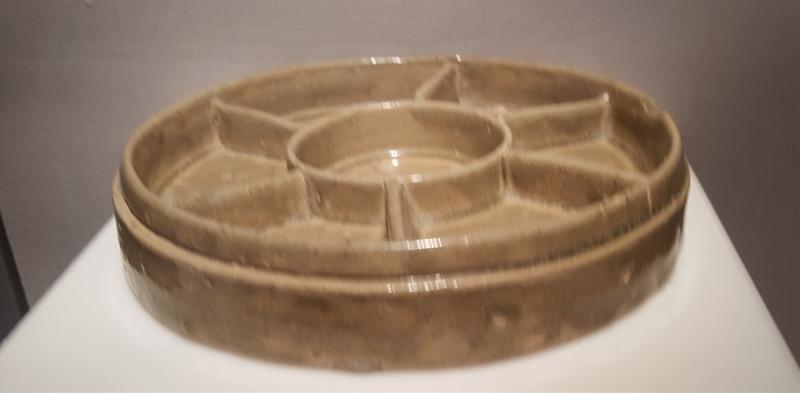
reception desk will not call me to wake me up, they state.
Turning around from the reception we are encircled by the group. Carl points out to us, four ladies: “I guess it is time to say good bye now!” I kiss and hug Wai Lan and Ting-tiang; I hope to see them again in the Netherlands soon - saying bye to Carl is more difficult, as he lives in Italy. He points out to me, that I should continue standing on my head to relax and thus see things differently.
We all dive into the elevators back to our rooms; in a few hours our train will leave Hangzhou.
I am sneezing. Tomorrow I will be in a metropole of 25 million people. Packing the luggage in my room that night goes as expected: standing and sitting on my luggage, – shaking and kicking it, jumping on my bag even to get it closed. Crackers inside break. I check my alarm clock settings ten times at least…and before I know it… fall asleep.
Pictures in this chapter (first to last; per line left to right):
1. Picture of Westlake by A. Waller (around 1867 AD) from the book "Half a century in China" by Arthur Evans Moule

2. Guan Kiln Vase
3. Northern Song (960 - 1127 AD) Yue kiln: a jar, a saucer and a Wu Zhou kiln pot
4. Dragon kiln of the Guan kiln in Hangzhou
5. Work in progress (under construction)
Links: under construction
Hangzhou
https://nl.wikipedia.org/wiki/Hangzhou
https://www.omropfryslan.nl/nieuws/386509-bijzonder-ru-schaaltje-tentoongesteld-museum-princessehof
http://www.newyorker.com/magazine/2016/10/17/the-fantastic-ursula-k-le-guin
http://www.minerals.net/gemstone/jasper_gemstone.aspx
https://en.wikipedia.org/wiki/Grand_Canal_(China)
Arthur Evans Moule "Half a century in China" foto's by A. Waller:
https://www.amazon.com/Half-Century-China-Recollections-Observations/dp/1314042572
Song history (in French)
https://fr.wikipedia.org/wiki/Dynastie_Song
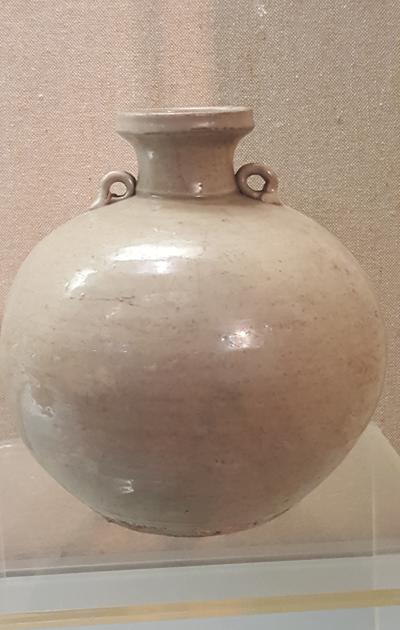
West Lake poems
http://www.chinaheritagequarterly.org/features.php?searchterm=028_graham.inc&issue=028
Huang Binhong: painter
http://www.chinaheritagequarterly.org/scholarship.php?searchterm=019_correspondence.inc&issue=019
https://fr.wikipedia.org/wiki/Huang_Binhong
Chang Shuhong: painter (the “Guardian of Dunhuang Caves”)
http://wap.chinadaily.com.cn/2016-01/21/content_23179425.htm
https://en.wikipedia.org/wiki/Mogao_Caves
Calligrapher Sha Meghai (page 133):
https://books.google.fr/books?id=y2ahlsvtHbsC&pg=PA133&lpg=PA133&dq=calligrapher+Chinese+Hangzhou&source=bl&ots=qwwynLDKKf&sig=PGHiCpj2Lnn_S0-tBaDWOXymDXw&hl=fr&sa=X&ved=0ahUKEwj10ZGxzazYAhXEL8AKHaRcBDIQ6AEIZDAK#v=onepage&q=Hangzhou&f=true
Su Shi: poet and governor during the Song dynasty
http://www.chinaonlinemuseum.com/calligraphy-su-shi-red-cliff.php
Pagoda Leifeng
https://en.wikipedia.org/wiki/Leifeng_Pagoda
Get started right away!
What are you waiting for? Capture your adventures in a digital diary that you can share with friends and family. You can switch between any of your devices anytime. Get started in our online web application.
